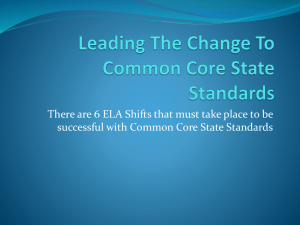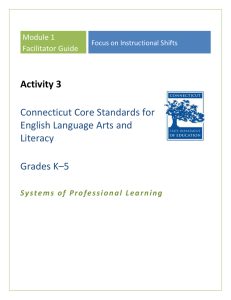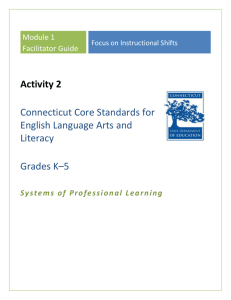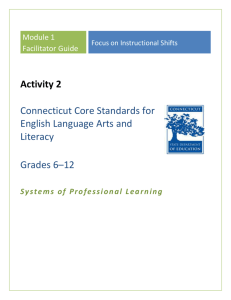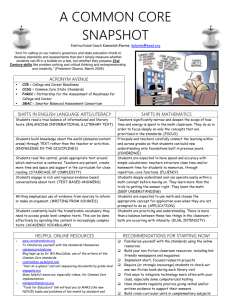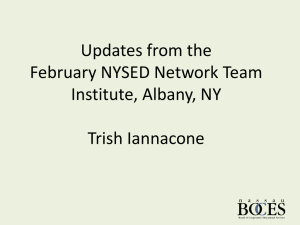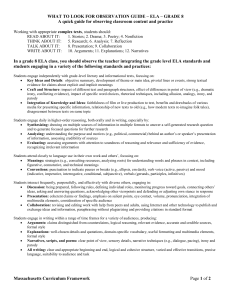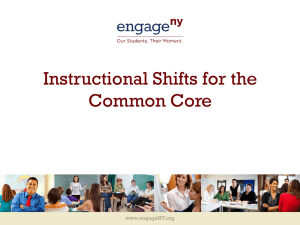M1_ELA_6-12_A4_Facilitator_Guide
advertisement
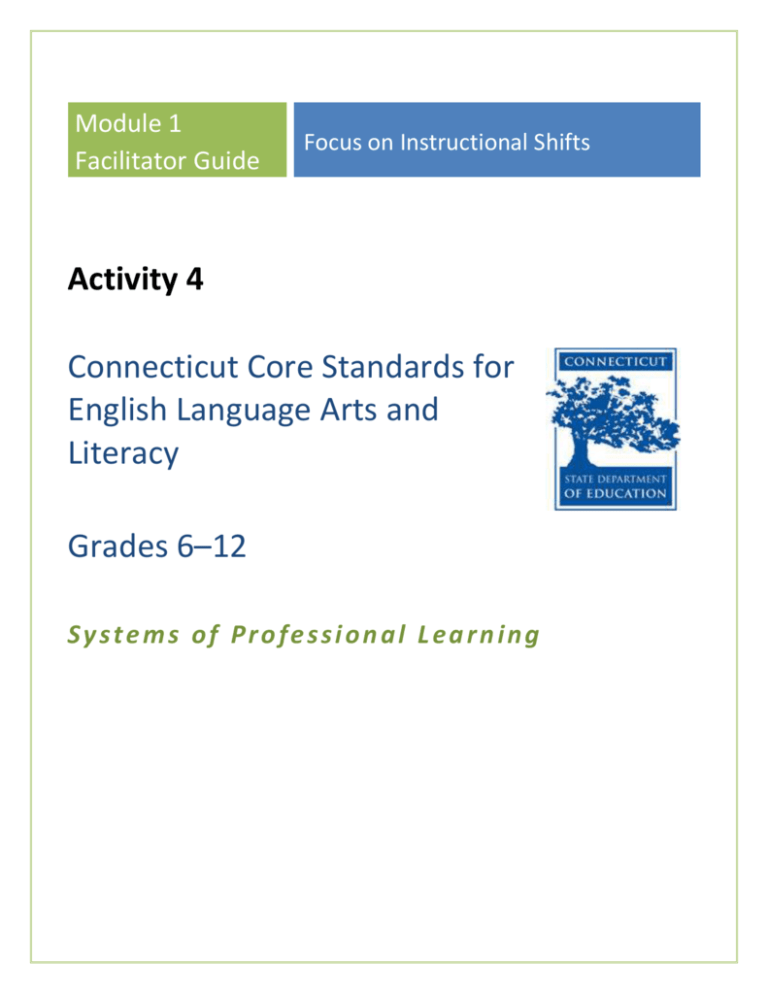
Module 1 Facilitator Guide Focus on Instructional Shifts Activity 4 Connecticut Core Standards for English Language Arts and Literacy Grades 6–12 Systems of Professional Learning Connecticut Core Standards for ELA & Literacy Module 1 Facilitator Guide Grades 6–12: Focus on Instructional Shifts Session at-a-Glance Activity 4: Complex Text and its Academic Language (50 minutes) In table groups of 6–8, 9–10, and 11–12 educators, coaches will reflect on a video of a lesson that is aligned with Shift 3: Regular practice with complex text and its academic language. Participants will pay careful attention to text-dependent questions focused on the text’s academic language. For application and practice, groups will read a short excerpt of grade appropriate, complex, informational text from Appendix B. They will discuss what teachers would need to do to instruct, support, and scaffold students in Regular practice with complex text and its academic language. Table groups will continue adding to the anchor chart from Shifts 1, and 2, Step 3. On the chart, they will record essential take-aways related to Shift 3, questions or areas they would like to explore further, and supports that teachers will need to implement Shift 3 effectively. * *Following lunch, participants will be encouraged to take a “gallery walk” to look at and compare anchor charts from different groups/grade levels. They will be given an opportunity to reflect on similarities and differences among charts. Questions from the charts will be used in planning subsequent modules and/or follow-up webinars. (15 minutes) Supporting Documents: Directions America Achieves instructional video and sample lesson plan Excerpts from CCS Appendix B PowerPoint Slides: 44–58 1 Connecticut Core Standards for ELA & Literacy Module 1 Facilitator Guide Grades 6–12: Focus on Instructional Shifts Session Implementation Activity 4 Slide 44 This slide introduces Shift 3: Regular practice with complex text and its academic language. There are two key interrelated ideas here – text complexity and development of academic vocabulary. The latter refers to both academic language (e.g.., analyze, synthesize, evidence, proclamation) and knowledge and use of domain-specific terms (e.g.., terms and words you need to understand to read, write and talk about specific topics in different content areas such as science, social studies and technical subjects). Slide 45 When this shift is shown as two shifts, the concept “Staircase of Complexity” is used to describe using increasingly complex texts with increasingly complex tasks. Staircase of complexity is about rigor – more complex tasks with more complex texts. Experts agree that academic language is a key factor in text complexity. 2 Connecticut Core Standards for ELA & Literacy Module 1 Facilitator Guide Grades 6–12: Focus on Instructional Shifts Slide 46 Just as evidence appears throughout the CCS-ELA & Literacy, so does complexity. Academic vocabulary and language including text structure and syntax are primary sources of text complexity. It very important that students develop deep understanding of vocabulary and language structure if they are to become proficient readers and writers. Hence, the third shift in instruction is to devote much more instructional time to vocabulary acquisition and language structure, primarily in the context of reading grade appropriate text. Slide 47 There is a tendency to focus on quantitative measures of text complexity; however, there are numerous examples of texts that are seemingly simple in structure but complex in nuance and meaning. Students’ background knowledge can greatly influence the complexity of text for that particular student. Note: We will go more deeply into the implications of text complexity in Module 2. 3 Connecticut Core Standards for ELA & Literacy Module 1 Facilitator Guide Grades 6–12: Focus on Instructional Shifts Slide 48 From CCSS Appendix A: Research indicates that the demands that college, careers, and citizenship place on readers have either held steady or increased over roughly the last fifty years. Furthermore, students in college are expected to read complex texts with substantially greater independence (i.e., much less scaffolding) than are students in typical K– 12 programs. Despite steady or growing reading demands from various sources, K–12 reading texts have actually trended downward in difficulty in the last half century. Lexile is one quantitative measure. The stretch Lexile band was intended to close the complexity gap between high school texts and college texts. Slide 49 This slide provides a sample of complex and simple text based on the same social studies passage. The top of the screen represents John F. Kennedy’s actual words. On the bottom, the vocabulary and sentence structure have been simplified. Again, ask for a few observations about the texts from participants. Allow 2-3 minutes for discussion. More complex texts and at every grade level More rigorous conversations More time and multiple reads on complex texts Provide scaffolding; i.e., reading/thinking aloud, digital media to build background knowledge, routines for reorganizing text and collaborative activities such as reciprocal teaching. 4 Connecticut Core Standards for ELA & Literacy Module 1 Facilitator Guide Grades 6–12: Focus on Instructional Shifts Teach annotation techniques. Use leveled texts carefully to build independence; do not supplant opportunities for engagement with grade level complex text. Use TDQs – both teacher and student generated. Slide 50 This introduces the next topic. Ask someone to read the slide. Invite participants to discuss. What does Adams mean when she says, “Words are not just words”? Slide 51 Found in Appendix A. Tiers are credited to Beck, I. L., McKeown, M. G., & Kucan, L. (2008). Creating robust vocabulary: Frequently asked questions and extended examples. New York, NY: Guilford. 5 Connecticut Core Standards for ELA & Literacy Module 1 Facilitator Guide Grades 6–12: Focus on Instructional Shifts Slide 52 Background for Presenter: Tier 2 and Tier 3 words are considered academic vocabulary. Both are important to understanding content and ideas. Tier Three words are obviously unfamiliar to most students, contain the ideas necessary to a new topic, and are recognized as both important and specific to the subject area. Teachers often define Tier Three words prior to students encountering them in a text and then reinforce their acquisition throughout a lesson. Tier Three words are often defined in context by the author of a text, or are in bold and in a glossary. Vocabulary development for these words occurs most effectively through a coherent course of studying which subject matters are integrated and coordinated across the curriculum and domains become familiar to the student over several days or weeks Tier Two words are not unique to a particular discipline and are far less well defined by contextual clues in the texts in which they appear .They are frequently encountered in complex written texts and are particularly powerful because of their wide applicability to many sorts of reading. Teachers need to be alert to the presence of Tier Two words and determine which ones need careful attention. Information from Common Core State Standards, Appendix A http://www.corestandards.org/ELA-Literacy Slide 53 (Allow 10 minutes for this Turn and Talk.) 6 Connecticut Core Standards for ELA & Literacy Module 1 Facilitator Guide Grades 6–12: Focus on Instructional Shifts Direct participants talk in pairs to identify Tier 2 and 3 words in this excerpt. Ask for examples. Slide 54 Many of the words like “layers,” “surface,” “pours forth” can appear in academic texts in both literal and figurative contexts (this would seem plausible on the surface; Tier 2 – layers, crust, pours forth, surface, eruption – Tier 3 word, spouted, molten, mantle, magma, lava Which words are critical to understanding the text? If there are too many, which can you ignore? Which words can be defined in context? (Remind teachers that when you are teaching kids to define words in context through TDQ’s, you are teaching them to read complex text independently) Which words could be the basis for further word study? Slide 55 This slide introduces Activity 4. Before participants begin, make sure everyone knows where the directions are located in the participant packet for watching and discussing the video exemplar. This time the focus is on reading, writing and talking about the text. View a video of instruction related to Shift 3 and discuss your observations (20 minutes total). Tell participants that they are going to view a segment of a video lesson that show an eighth grade class reading closely, the Declaration of Independence. The lesson plan for the video lesson is included in the resources for this activity. We 7 Connecticut Core Standards for ELA & Literacy Module 1 Facilitator Guide Grades 6–12: Focus on Instructional Shifts are focusing on the text-dependent questions focused on academic language the teacher asks and the student responses. Activity Resources: Activity Participant Guide for directions Video exemplar, lesson plan and discussion prompts Video: http://commoncore.americaachieves.org Grade 8, History/ English Language Arts Segment 5: 00:07:25, Segment 6: 00:7:40, Segment 8: 00:09:30 to end (approximately 5 minutes total) 1. Tell participants that as they watch the video, they should take careful notes on the text-dependent questions that the teacher poses about academic language and the students’ responses to the questions. Do the questions specifically address content-rich material in the text? What types of questions does the teacher ask? Are students successful in responding to the questions? Ask participants to pay special attention to the way that the teacher helps students become close readers as they build content knowledge related to the CCS-ELA reading standards for the lesson as identified on the lesson plan. (4 minutes to watch the video) 2. After watching the video, ask participants to “turn and talk” to their neighbor to discuss what they observed in the video that exemplifies the value of text-dependent questioning in close reading to unlock academic language. Peer pairs then share their ideas with others at the table. (10 minutes to discuss) 3. One volunteer will share an idea from the table with all participants. (2 minutes to share) Slide 56 The point of an anchor chart is to anchor the teaching and learning that is happening in the classroom. We will create anchor charts to note the key points or “take-aways” from our work with each of the three shifts today. Later on, you’ll have the opportunity to see and comment upon what others have written. 8 Connecticut Core Standards for ELA & Literacy Module 1 Facilitator Guide Grades 6–12: Focus on Instructional Shifts Slide 58 In like groups participants will review the shifts anchor charts. Allow 10 minutes after break. Ask them to make notes charts using sticky notes. After time has been allowed to view all charts, ask those nearest the charts to share comments on the charts. 9
